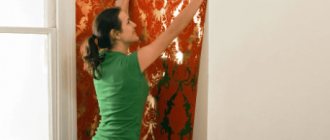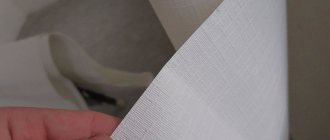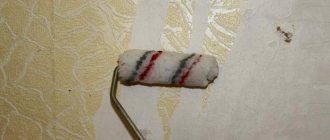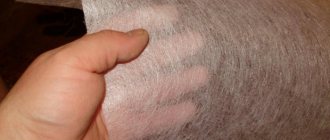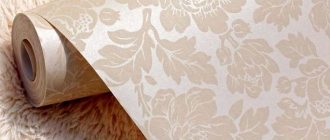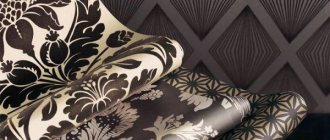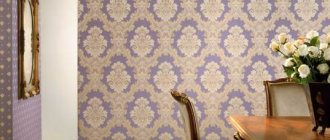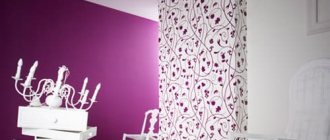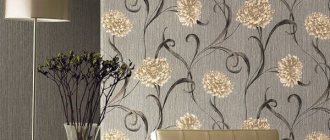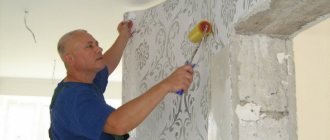Repairs, including those done by yourself, are a responsible undertaking and not always quick. There is not always plenty of time for it, so it is important to know exactly the duration of each stage. One of the most common activities when improving an apartment is wallpapering. It is permissible to use different types of such material, for example, non-woven, vinyl and some others.
However, when covering walls with any type of wallpaper, haste is not only inappropriate, but in most cases can harm the quality of this coating.
For this reason, it is very important to strictly follow all manufacturer's recommendations. And also know exactly how long it takes for wallpaper to dry after gluing, and how to speed up this process, without the risk of peeling and spoiling the appearance.
General factors relevant to wallpaper drying
The process of complete drying of wallpaper is directly influenced by a combination of several general factors. These include:
- the material of the wallpaper itself, chosen for gluing the surface of walls or ceilings;
- adhesive used;
- indoor air temperature;
- humidity level in the room.
And most importantly, never rush to start using the room before the wallpaper has completely dried. Excessive haste will only lead to the fact that you will need the next repair much earlier than planned. This, in turn, will lead to unnecessary financial costs and may disrupt all your business and household plans. You don't want this, do you?
Choosing wallpaper glue
When was the last time you made wallpaper glue yourself? But those who lived 30 years ago probably remember the era of total shortages and a homemade recipe for making universal wallpaper glue from ordinary flour and tap water. It was called paste and was used almost everywhere. However, wallpaper in those distant times was mainly paper-based.
Today everything has changed dramatically. There are quite a lot of materials for wallpaper. Surely everyone is hearing non-woven fabric and vinyl. These are the bases most often used in modern wallpaper production. Accordingly, special adhesive compositions are produced for them, having different drying times. Methods for preparing glue, as well as the recommended drying time, are indicated by manufacturers on the packaging of such mixtures and it is imperative to adhere to them.
Let us add that the drying time of the wallpaper is directly influenced by the quality of preparation of the wall before decorating, the level of humidity in the room, and several other factors, including those that we have already discussed above. Now let's look at the recommended drying time for wallpaper depending on the type of base, but let's talk about this more specifically after answering the question - how long does it take for the primer to dry.
Preparatory work
Before gluing the trellises to the base, you need to prepare the surface of the walls, the wallpaper itself and the adhesive composition.
Preparing the base
The base for the wallpaper must be smooth and clean. It is not necessary to bring the surface to perfection (vinyl trellises mask small errors well), but large cracks, sagging and dirty spots need to be eliminated.
The procedure for preparing the base:
- electrical installation products are being dismantled;
- the plinth and fillet from the ceiling are dismantled, the trim is removed from the doorways;
- the previous covering is removed (wallpaper, paint, decorative plaster);
- The wall surface is checked. Weak spots are cleaned and puttied, cracks and chips are sealed with plaster mortar;
- removes greasy and dirty stains;
- A primer is applied to the surface;
- gypsum board sheets must be completely puttied; for concrete or plastered walls this operation is not necessary;
- after puttying, it is necessary to re-treat the surface with a primer or an adhesive solution strongly diluted with water;
- balcony doors and windows are closed not only in winter, but also in the warm season (spring, autumn, summer).
The process of preparing walls is described in more detail in this article.
Preparation of material
In order not to waste time preparing the canvases, combining this work with gluing them to the walls, it is recommended to trim all the trellises in advance. The canvases are sized using butt gluing technology, rather than overlapping:
- a preliminary plan for placing each sheet on the wall is drawn up;
- by measuring the height of the surface, find the length of each strip;
- the roll is rolled out on the floor with the inside side up, having previously placed plastic film on the floor to protect the pattern;
- a mark is placed along the length of the first canvas;
- According to the mark, the canvas is bent, after which it is cut with a sharp knife at the bend. The next canvas is cut using the same algorithm;
- If it is necessary to adjust the pattern, when marking, you should take into account the joining location, laying two strips side by side with the front side facing up.
Preparation of the adhesive composition
When preparing the adhesive composition, it is best to pay attention to the instructions on the product packaging and not deviate from the manufacturer’s recommendations.
How long should wallpaper primer dry?
Neglecting the primer can negate all efforts to properly wallpaper. Therefore, you will have to spend time applying it and drying it on the wall if you do not want to waste time and money on repairs.
Primer mixtures:
- strengthen the base - after impregnation, the process of shedding is reduced;
- improve adhesion (adhesion between the wall surface and wallpaper);
- impart uniform properties to surfaces of different compositions.
Depending on the binder used in the primer base, different mixtures have different drying times:
- Acrylic based - dry up to 5 hours.
- Alkyd – 10-15 hours.
- Glypthal - 5-20 minutes.
Sergey Yurievich
Construction of houses, extensions, terraces and verandas.
Ask a Question
The exact drying time depends on the porosity of the material, the surface and the room temperature. The recommended temperature for drying most primer mixtures is +25 degrees.
Required materials and tools
The right tool and material will allow you to complete the complex job of gluing vinyl trellises with your own hands with high quality.
The following materials will be required:
- required number of rolls of wallpaper;
- glue for vinyl wallpaper;
- primer
You need to prepare the following tools:
- trestles or stepladder;
- container for preparing adhesive solution;
- water container;
- electric drill with an attachment for preparing a solution;
- primer container;
- long strip for marking the wall;
- a roller with cloth paper to apply primer to the walls;
- construction plumb line;
- brush; for primer;
- spatula 200-300 mm;
- pencil;
- roulette;
- knife;
- wallpaper spatula;
- rubber roller 300-400 mm wide;
- cone-shaped rubber roller;
- glue brush 50 mm;
- wipes for removing excess glue.
Which glue to choose
When choosing an adhesive composition, you need to pay attention to the following characteristics:
- absence of allergens released at room temperature;
- the glue must have excellent adhesion and hold heavy panels;
- it is desirable that the composition can be stored for a long time in finished form;
- should glide well over the surface - this will make adjustment easier;
- resist the effects of fungus and mold;
- be colorless.
The following brands meet these requirements:
- "Cleo"
- "Metylan";
- "Quelyd";
- "Moment".
If in doubt, you should purchase compounds labeled “for paper and vinyl wallpaper.”
Calculation of the number of rolls
When calculating the number of rolls required to cover the surface, use the following method (calculation assumes end-to-end fitting, not lengthwise):
- The height of the surface planned for finishing is measured.
- The length of the roll is divided by the height of the surface - we get the number of finished trellises from one tube.
- The width of the surfaces is measured and divided by the width of the strip. We get the number of stripes.
- We divide the total number of strips by the number of trellises in one tube and get the number of rolls.
If you need to adjust a design that is more than 6 cm high, you will have to add an additional roll for every six rolls.
Calculation of the amount of glue
To calculate the amount of adhesive composition, you need to look at the instructions on the pack and find out how much ready-made solution is required to glue 1 standard roll. Next, by multiplying the norm by the number of rolls, the required amount of adhesive composition is found.
How long does it take for vinyl wallpaper to dry?
Provided the room temperature is maintained in the range of 25-30 degrees with a humidity level of 60%, it will take 48 hours for vinyl wallpaper to dry. When using weighted vinyl sheets with complex decorative elements on the surface, you will have to be patient - you will have to wait a week for the pasted surface to dry.
You should not rush to continue other finishing work, and, moreover, you should not perform other work or ventilate the room from excess moisture. This will not affect the drying time of vinyl wallpaper, but the result may be disastrous.
How long does non-woven wallpaper take to dry?
It is hardly worth saying that non-woven wallpaper is considered the most popular among the population. However, the quality of the coating depends not only on strict adherence to the manufacturer’s recommendations for the selection and use of glue, but also on its drying time.
Provided that the room temperature is at least 15 degrees, it will take at least a day for non-woven fabrics to dry. If the temperature is lower, or you are using non-woven wallpaper for subsequent painting, wait 48 hours.
To find out that the surface is completely dry and you can continue working, run your palm over the surface of the wallpaper - you should not feel any moisture on your hand. If the surface is wet, wait until it dries completely.
What you need to pay attention to
So, let's look at what the drying conditions should be and what affects the drying time.
Material used to cover the walls
It has already been said about wall material; even drywall today is covered with a putty layer. The only thing that should be noted is that putties come in a fairly wide range, including gypsum, cement, polymer, oil, and so on. Each type has its own properties, for example, the gypsum version quickly absorbs moisture, so non-woven wallpaper glued to it will dry faster.
Adhesive composition
As for the adhesive solution, there are a huge number of types and subspecies. In any case, you should only use adhesives for non-woven wallpaper. The less time it takes for the material to adhere to the wall, the faster drying will occur.
Indoor temperature and humidity
Now the most important drying conditions. This is the temperature and humidity inside the rooms. What generally accepted standards must be taken into account in order to carry out drying correctly. There are several of them:
- Sudden changes in humidity are prohibited.
- There is no sudden air movement, so you will have to close the windows and doors while the wallpaper dries.
- You cannot dry the finish artificially, for example, by turning on heaters of any kind.
- All other repair and finishing work in rooms where non-woven wallpaper was pasted must be stopped while drying is taking place.
Attention! Pasted non-woven wallpaper should dry only naturally. The only thing you need to take care of is good ventilation.
Why can't you dry wallpaper artificially? The thing is that the quickly removed moisture, which is in the adhesive composition, destroys the bonds between the components of the adhesive. And this reduces not only the strength characteristics, but also the elasticity of the material. The latter indicator affects the ability of the wallpaper to move slightly during the drying process, which is especially important in new buildings when the building undergoes natural shrinkage.
High humidity (above 60%) will create conditions under which the adhesive solution will take longer to dry. In this case, the wallpaper will gradually begin to slide down under its own weight, which means a decrease in quality, the appearance of wrinkles, and so on. Low humidity (below 40%) is also not good. The glue will begin to release moisture into the room, which means the natural drying process will begin to speed up. This will definitely lead to the corners and edges of the wallpaper strips coming off.
When it comes to temperature, there are a few warnings.
- Non-woven trim cannot be glued below +7C.
- Optimum temperature +15 - +25C.
- At temperatures below +15C the drying process slows down. Consequences - the finish will begin to slide under its own weight.
- At temperatures above +25C the drying process accelerates. It’s just that during this time the wallpaper will not be able to adhere well to the wall surface. The consequences are exactly the same as in the case of low temperature.
What did the experts who knew first-hand about non-woven wallpaper come to? Those who have spent a long time covering walls and ceilings with non-woven wallpaper know that it takes at least a day to dry it. The ideal option is two days. Of course, after this period you can enter the premises and carry out other work. But some things cannot be done. For example, you cannot install suspended ceilings, because during their installation a heat gun is used, which will speed up the drying process. You can’t paint the wallpaper itself right away; it’s better to do it after a week.
As you can see, the drying time of non-woven wallpaper affects the quality of the final result. Therefore, it is very important to listen to the opinions of experts.
- Do-it-yourself soundproofing of walls
- How to veneer walls with your own hands
- Wallpaper options for the kitchen with photos
- Grouting ceramic tiles
Sooner or later, we all face the need to make repairs. Some people prefer to delegate these jobs to professionals, while others do them themselves. When making repairs on your own for the first time, many questions arise. We don’t suffer from a lack of information at all; it’s always easy to open the Internet and study everything in detail: watch videos and photographs, but sometimes we still can’t find a clear answer.
The wallpapering process is in full swing
In this case, we will focus on the nuances of gluing vinyl wallpaper and their drying time. You can immediately determine some time frames, note: vinyl wallpaper dries from 24 to 48 hours. But is this so, and under what conditions, more specifics are needed. Let's try to delve deeper into this issue and consider all possible options for the development of events.
If you used a rotband
When using rotband for preliminary preparation of the surface for gluing wallpaper, wait until this plaster mixture has completely dried. Further, all the recommendations we described above apply. This applies to the type of wallpaper, the need to use primers, and the time it takes to dry. Be sure to note that there should be no drafts.
When using rotband, use a primer from the same manufacturer. This way you will ensure the best compatibility of materials when performing wallpaper work.
